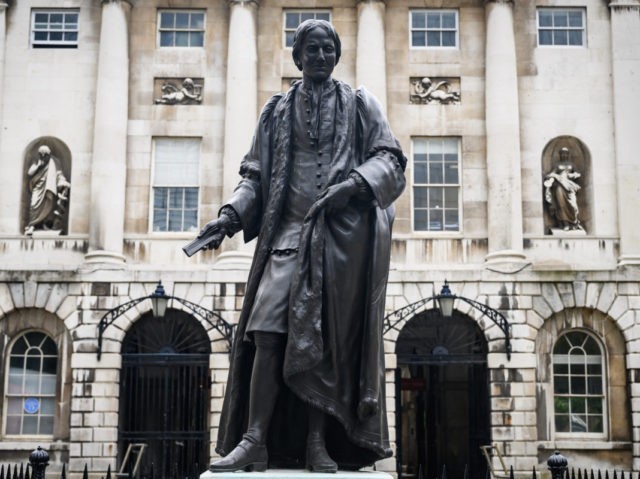Emboldened by the zero-resistance police response to the destruction of a statue on Sunday, a hard-left campaign group with a history of high-profile activism has published a list of dozens of other public memorials targeted for removal.
Published by the Stop Trump Coalition, and by their own reckoning, a “project in support of the Black Lives Matter movement and the topplers of Edward Colston”, the Topple The Racists list names dozens of statues and other memorials to figures from British and world history that have been judged unworthy by 21st century standards.
Among the list are several perennial hate-figures for the left, including famed explorer and mariner Christopher Columbus, and Elizabethan privateer Sir Francis Drake. Oliver Cromwell, on the other hand, is often cited as a hero to the British left because his victory in the English Civil War saw the ruling monarch beheaded, and his rule replaced by a radical republic. Nevertheless, several Cromwell statues are named.
Many have connections to the slave trade, but some more tenuously than others. A monument to the Earl Grey is one listed, despite Grey having been a major reformer in his time who, among other liberalising achievements, abolished slavery in the British Empire in 1833. His statue is cited for removal because of the method the British government used to end the practice, which was effectively buying all of the slaves from their owners across the Empire and then setting them free.
After Britain banned slavery, the Royal Navy was tasked with stamping out the practice across the Atlantic, its West Africa Squadron engaging in decades of pursuits of slaver ships.The cost of buying the freedom of the slaves was equivalent to over a third of the whole expenditure of the British government that year, and was so expensive it took the government nearly two centuries to pay back a loan taken out to finance the law.
Other figures highlighted include several statues of Sir Robert Peel, another Victorian reformer who founded the modern British police force, and Victoria Cross medal recipient General Sir Redvers Buller.
While the list leaves precisely how the statues should be removed as a somewhat open-ended question, praising the illegal destruction of one while linking to petitions and campaigns for others, it remains the case that other statues are already being removed, and voluntarily by left-wing controlled local government in some cases. Several statues have already been vandalised, while demonstrations against others have taken place.
Within hours of the Topple Rasists website going live, the first of the statues on the left-wing list fell, as a 200-year-old memorial to Robert Milligan in East London was lifted off its podium by a tractor on orders of local government.
Breitbart London has contacted 15 UK territorial police forces who have statues and other memorials listed as targets in their geographical areas of responsibility, asking whether they would intervene to prevent crimes being committed, or if they would — like Bristol police — take a “tactical decision” to allow mob destruction to go ahead.
The way in which the targets have been chosen, apparently plucked from the Wikipedia entries for a catalogue of soon-to-be erased historical figures, echoes the arbitrary target selection for a series of deadly bombing raids against Britain’s built heritage, history, and citizens during the Second World War.
The Baedeker raids, so-called, were a series of high-explosive and incendiary bombing raids against English cities in 1942 by the airforce of Nazi Germany. In contrast to earlier raids which had focussed on military and industrial targets, the raids struck historical and cultural centres.
The raids were named after a famous series of pre-war guides meant to guide German tourists around sites of historic importance, and the strikes were launched to break the spirit of the British by destroying their cultural heritage.
The raids struck some of the oldest and best-preserved historic towns in England. The raids began in Exeter in England’s South West, striking the Cathedral with high explosives and demolishing much of the ancient town centre. What the Nazis began in 1942 the local authorities, sadly, continued after the war.
Other cities struck were Bath — a then-complete Regency city of global importance, again further damaged post-war by modernist planners — Medieval Canterbury, York, and Norwich.

COMMENTS
Please let us know if you're having issues with commenting.